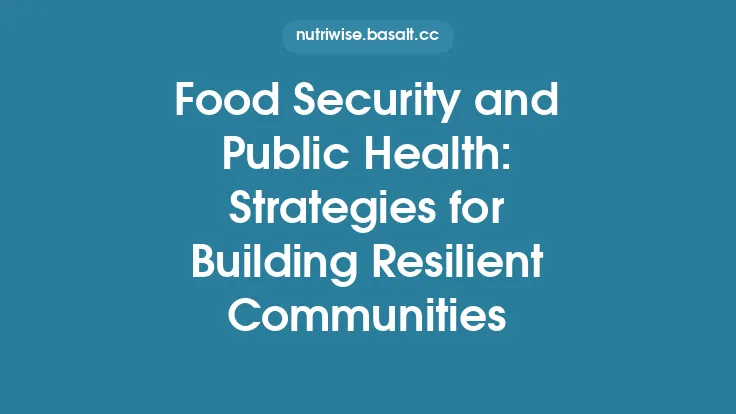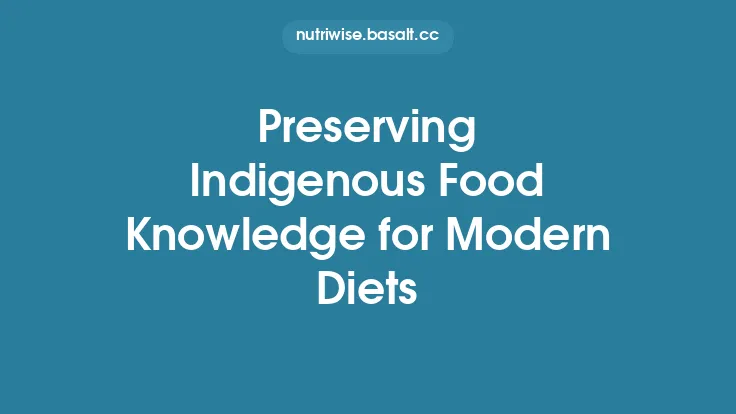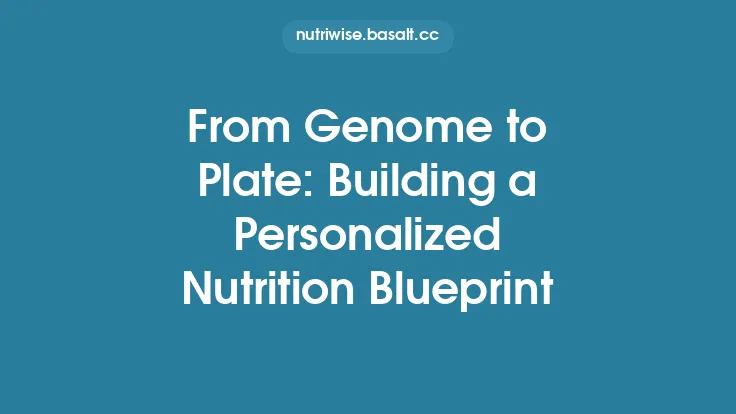Community‑based nutrition initiatives have emerged as a cornerstone of sustainable public‑health practice, offering a pragmatic bridge between scientific evidence and everyday dietary behaviors. Unlike top‑down policy instruments that rely on legislation or fiscal levers, these programs are rooted in the lived realities of the populations they serve. By leveraging local assets, fostering participatory governance, and embedding nutrition knowledge within community structures, they create resilient pathways for improving dietary quality over the long term. The following discussion unpacks the essential components, methodological considerations, and translational lessons that can guide researchers, practitioners, and policymakers seeking to embed nutrition improvement within the fabric of community life.
Defining Community‑Based Nutrition Initiatives
Community‑based nutrition initiatives (CBNIs) are organized, locally driven actions that aim to modify dietary patterns, enhance food literacy, and improve nutritional status among specific populations. Key defining attributes include:
- Geographic or Social Boundedness – The target group is delineated by a neighborhood, cultural enclave, or shared identity (e.g., indigenous community, migrant workers).
- Participatory Design – Community members co‑create goals, strategies, and evaluation metrics, ensuring relevance and ownership.
- Multilevel Intervention – Activities span individual behavior change, interpersonal support networks, and environmental modifications (e.g., community gardens, local markets).
- Sustainability Orientation – Programs are structured to persist beyond initial funding cycles, often through capacity building and integration with existing community institutions.
These criteria distinguish CBNIs from broader public‑health campaigns that may lack localized tailoring or from clinical nutrition interventions that operate primarily within health‑care settings.
Core Principles of Sustainable Community Nutrition Programs
Sustainability in the nutrition context is multidimensional, encompassing ecological, economic, and social domains. Successful CBNIs consistently embody the following principles:
- Cultural Congruence – Dietary recommendations are aligned with traditional foodways, taste preferences, and cultural rituals. This reduces resistance and enhances acceptability.
- Asset‑Based Approach – Rather than focusing on deficits, programs identify and mobilize existing community strengths such as local food producers, social clubs, and informal knowledge networks.
- Ecological Integration – Initiatives often incorporate environmentally sound practices (e.g., agroecology, low‑input gardening) that simultaneously support nutrition and ecosystem health.
- Economic Viability – By fostering micro‑enterprise (e.g., community‑run produce stands) or leveraging cooperative purchasing, programs mitigate cost barriers to healthy foods.
- Iterative Learning – Continuous feedback loops allow adaptation to emerging challenges, ensuring relevance over time.
When these principles are operationalized, interventions are more likely to endure, generate local employment, and reinforce community cohesion.
Stakeholder Engagement and Co‑Creation
Effective stakeholder engagement proceeds through a structured, yet flexible, process:
- Mapping and Prioritization – Identify formal (e.g., local health departments, NGOs) and informal (e.g., faith leaders, elder councils) actors. Prioritize those with decision‑making authority or strong social influence.
- Participatory Workshops – Use facilitation techniques such as World Café or Delphi panels to elicit community insights on dietary challenges, preferred solutions, and perceived barriers.
- Co‑Design of Intervention Logic Models – Collaboratively develop a theory of change that links activities (e.g., cooking classes) to short‑term outputs (e.g., increased nutrition knowledge) and long‑term outcomes (e.g., reduced prevalence of micronutrient deficiencies).
- Governance Structures – Establish community advisory boards with clear terms of reference, ensuring representation across gender, age, and socioeconomic strata.
- Capacity Building – Provide training in project management, data collection, and advocacy to empower community members to lead and sustain the initiative.
This co‑creative paradigm not only improves program relevance but also cultivates local leadership that can champion nutrition beyond the lifespan of any single project.
Evidence‑Based Intervention Design
While community ownership is paramount, interventions must be anchored in robust scientific evidence. The design process typically involves:
- Systematic Review of Local Dietary Data – Compile existing surveillance (e.g., household consumption surveys) to pinpoint nutrient gaps and food sources.
- Behavioral Theory Integration – Apply frameworks such as the Social Ecological Model, Self‑Determination Theory, or the COM-B (Capability, Opportunity, Motivation – Behavior) system to structure behavior‑change components.
- Pilot Testing – Conduct small‑scale feasibility studies to assess acceptability, logistical constraints, and preliminary efficacy.
- Implementation Science Tools – Use the Consolidated Framework for Implementation Research (CFIR) to anticipate contextual facilitators and barriers.
By marrying local insight with evidence‑based methodology, CBNIs achieve a balance between relevance and rigor, increasing the likelihood of measurable health impact.
Monitoring, Evaluation, and Adaptive Management
Sustainable programs require ongoing assessment that informs real‑time adjustments. A comprehensive M&E framework includes:
| Dimension | Indicator Example | Data Source | Frequency |
|---|---|---|---|
| Process | Number of community members trained as peer educators | Training logs | Quarterly |
| Output | Meals prepared using locally sourced ingredients | Kitchen inventory | Monthly |
| Outcome | Change in mean daily fruit and vegetable servings | 24‑hour dietary recalls | Baseline & 12 months |
| Impact | Prevalence of anemia among women of reproductive age | Hemoglobin testing | Baseline & 24 months |
| Equity | Participation rates by socioeconomic quintile | Survey demographics | Ongoing |
Key practices for adaptive management:
- Rapid Feedback Cycles – Use short‑term indicators (e.g., attendance at nutrition workshops) to tweak outreach strategies.
- Participatory Data Review – Involve community advisory boards in interpreting findings, fostering shared accountability.
- Iterative Budget Reallocation – Shift resources toward high‑impact activities identified through data (e.g., expanding mobile produce markets if demand is high).
Such a dynamic evaluation system ensures that programs remain responsive to shifting community needs and resource landscapes.
Scaling Up and Replication Strategies
When a CBNI demonstrates effectiveness, scaling must preserve its community‑centric ethos. Strategies include:
- Modular Design – Break the program into interchangeable components (e.g., nutrition education module, market linkage module) that can be adapted to different contexts.
- Knowledge Transfer Networks – Establish peer‑learning circles where successful communities mentor emerging sites, facilitating cross‑site learning without imposing a one‑size‑fits‑all model.
- Policy Alignment without Direct Mandates – Position the initiative as a complement to existing municipal health plans, leveraging non‑regulatory incentives (e.g., grant eligibility, recognition awards).
- Economic Modeling – Conduct cost‑effectiveness analyses to demonstrate value to potential funders and to inform resource allocation for larger roll‑outs.
By emphasizing flexibility and peer support, scaling can occur organically, respecting local autonomy while amplifying impact.
Policy Integration without Direct Government Mandates
Although the focus is community‑driven, alignment with broader policy environments can amplify sustainability:
- Strategic Partnerships – Collaborate with municipal planning departments to incorporate community gardens into zoning ordinances, thereby securing land tenure.
- Funding Leveraging – Align program objectives with grant criteria from national health agencies, foundations, or corporate social responsibility portfolios.
- Advocacy for Enabling Environments – Mobilize community voices to advocate for supportive infrastructure (e.g., safe walking routes to markets) without demanding prescriptive legislation.
These approaches allow CBNIs to benefit from policy synergies while retaining their grassroots character.
Challenges and Mitigation Strategies
Even well‑designed initiatives encounter obstacles. Common challenges and evidence‑informed mitigations include:
| Challenge | Underlying Cause | Mitigation |
|---|---|---|
| Participant Attrition | Competing time demands, perceived irrelevance | Offer flexible scheduling, integrate activities into existing community events |
| Resource Constraints | Limited funding, scarcity of skilled facilitators | Train community volunteers as peer educators, pursue diversified funding streams |
| Cultural Misalignment | Interventions clash with traditional food practices | Conduct thorough cultural assessments, co‑create recipes that blend health goals with heritage |
| Data Collection Fatigue | Repeated surveys burden participants | Use mixed methods (e.g., short mobile surveys, focus groups) and provide tangible feedback to participants |
| Environmental Variability | Seasonal food availability affecting program continuity | Develop season‑agnostic nutrition messages, promote preservation techniques (e.g., drying, fermenting) |
Proactive planning and continuous community dialogue are essential to navigate these complexities.
Future Directions and Research Gaps
The field of community‑based nutrition continues to evolve. Emerging areas warranting attention include:
- Digital Integration – Exploring low‑cost mobile platforms for nutrition education, peer support, and real‑time monitoring while ensuring digital equity.
- Systems Modeling – Applying agent‑based models to simulate how changes in local food environments cascade through social networks and affect dietary outcomes.
- Longitudinal Impact Assessment – Conducting multi‑year cohort studies to capture sustained health benefits, intergenerational effects, and potential spillover to non‑participants.
- Intersectionality Analyses – Investigating how overlapping identities (e.g., gender, ethnicity, disability) shape access to community nutrition resources.
- Economic Resilience – Quantifying how community nutrition enterprises buffer households against economic shocks, thereby linking nutrition to broader socioeconomic stability.
Addressing these gaps will deepen our understanding of how community empowerment can serve as a durable engine for public‑health nutrition.
In sum, community‑based nutrition initiatives embody a pragmatic, culturally attuned, and resilient pathway toward sustainable public health. By grounding interventions in local assets, employing rigorous evidence‑based design, and fostering adaptive learning, these programs can generate lasting improvements in dietary quality while strengthening the social fabric of the communities they serve. The lessons distilled here provide a roadmap for researchers, practitioners, and policymakers committed to nurturing nutrition from the ground up.





